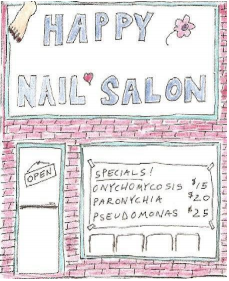Nail Salons Can Be Exciting: Things You Should Know Before Having a Manicure

Fungal Nail Infections
Nail fungus is very common and can be transmitted via contaminated nail utensils. If the salon is not fastidious
about cleaning the nail debris generated after each manicure or pedicure on the tables and other surfaces, you
can inoculate yourself with fungus from the previous client. If you have a nail fungus, you should use the scissors last on the infected nails and clean the scissors with alcohol after each use to avoid infecting uninfected nails.
Squamous Cell Carcinomas from UV Light
It is now common practice for nail salons to employ ultraviolet light nail lamps to dry nail polish and set acrylic nails. These devices are also available for purchase on the Internet for home use. Recently, two healthy middle-aged women with no personal or family history of skin cancer developed squamous cell carcinomas on the fingers and hands (reported in the Archives of Dermatology vol. 145 no.4 April 2009). One of the women had had 8 exposures to the nail lamp before developing multiple skin cancers on her hands and fingers. The ultraviolet light emitted from nail lights is predominantly UVA; these wavelengths are longer than UVB and penetrate deeper into the skin. Squamous cell carcinoma on fingers and toes can result in amputation of the digit depending on the invasiveness of the cancer. The Internet markets these lamps as a treatment for killing bacteria and making nails healthier. I do not concur with these claims and recommend against the use of these devices for drying nail polish. You should either let the nails dry naturally or use an electric or battery operated fan.
Tanning beds also emit UVA. This has been shown to cause DNA mutations leading to skin cancers. I question the safety of the popular salon practice whereby tanners insert a plastic mouthpiece into their mouths so that the UV tanning lights may activate teeth whitener while they tan. Oral cancer can be aggressive and readily metastasize to lymph nodes in the neck, which can lead to spreading to the rest of the body. You should inspect your fingers, toes, tops of hands and feet on a regular basis if you have been receiving exposure to UVA nail lamps. Should you notice a rough area of skin or a persistent localized red scaly area, I recommend you have a dermatologic evaluation.
Paronychia from Pushing the Cuticles and Cutting Nails Incorrectly
All manicurists without exception love to push the cuticle back as far as possible and then completely remove the cuticle using scissors. I have asked patients why they consent to having this done and no one can give me an answer. No one can give an explanation as to
why they think this is a good idea either. The cuticle is a physiologic seal between the nail plate and the skin. By violating this seal (pushing or cutting it off) you open up this space to bacteria, yeast, fungus, and viruses. This can lead to infection (which is very common). The skin around the nail will becomered, swollen, painful and you may see pus collecting underneath the skin. You may need to take oral antibiotics and seek dermatologic assistance to have the area opened and drained.
Skin Infections
In addition to the routine bacteria you may acquire, the foot bath also places you at risk for a group
of bacteria called mycobacterium. These infections can be difficult to eradicate, usually requiring multiple antibiotics be taken for 6-12 months. It is important that the tubing and the filters in the foot bath be clean and not just the tub in which you soak your feet.
Dented Fingernails
Dents and irregularities in the nail plate can result from overly aggressive manipulation of the cuticle. The tissue immediately next to the cuticle is the nail matrix. This contains the cells that make the nail
and when these cells are damaged, the nail will be deformed. If the cells are permanently damaged your nail will always grow out with dents or irregularities.
Ingrown Nails
Ingrown nails result from improper trimming of the nails. When the nail starts to grow out it grows into the side tissue of the nail causing inflammation. Do not let the manicurist cut your nails so the sides are curved below the tip of the finger. Toenails should be trimmed straight across and not curved inward on the sides of the nail. If you feel you must have a manicure or pedicure please take the following precautions:
Dr. Wong's Tips for Going to a Nail Salon
- Skip the foot bath
- Bring your own nail nippers, orange sticks, emery boards.
- Only patronize salons using proper sterilization techniques for equipment.
- Do not allow your cuticles to be pushed back or cut away.
- Do not use the UV nail lights for drying nail polish.
- Make sure all the surfaces in which you come in contact are clean or you personally wipe
surfaces with Clorox disinfectant wipes. - Make sure your nails are being trimmed properly.
- Periodically remove your nail polish and look at your nails. Do not keep getting the part that
is growing out touched up. You may leave an infection or abnormal pigmentation that could
be a melanoma undetected in the nail that needs medical attention - If you have diabetes, are taking immunosuppressant medications, are
immunocompromised, have an autoimmune disorder, have hand eczema or hand
dermatitis, or a skin infection, you should not go to a nail salon. It isn't worth taking
the risk.